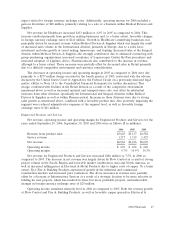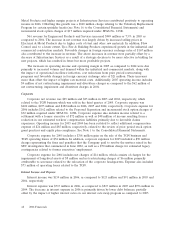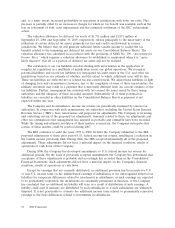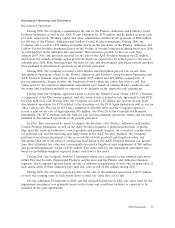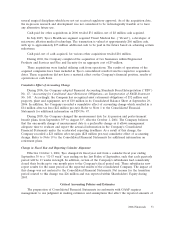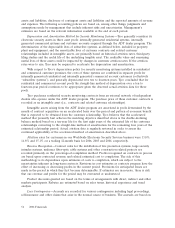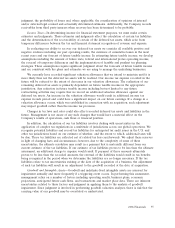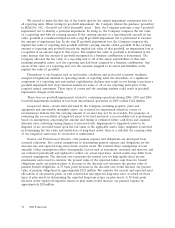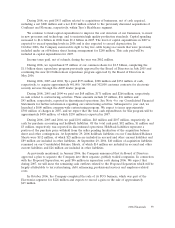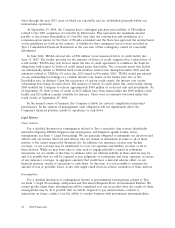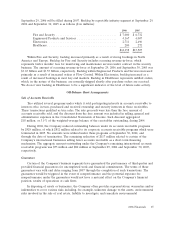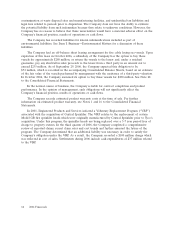ADT 2006 Annual Report Download - page 118
Download and view the complete annual report
Please find page 118 of the 2006 ADT annual report below. You can navigate through the pages in the report by either clicking on the pages listed below, or by using the keyword search tool below to find specific information within the annual report.We elected to make the first day of the fourth quarter the annual impairment assessment date for
all reporting units. When testing for goodwill impairment, the Company follows the guidance prescribed
in SFAS No. 142, ‘‘Goodwill and Other Intangible Assets.’’ First, the Company performs a step I goodwill
impairment test to identify a potential impairment. In doing so, the Company compares the fair value
of a reporting unit with its carrying amount. If the carrying amount of a reporting unit exceeds its fair
value, goodwill is considered impaired and a step II goodwill impairment test is performed to measure
the amount of impairment loss. In the step II goodwill impairment test, the Company compares the
implied fair value of reporting unit goodwill with the carrying amount of that goodwill. If the carrying
amount of reporting unit goodwill exceeds the implied fair value of that goodwill, an impairment loss is
recognized in an amount equal to that excess. The implied fair value of goodwill is determined in the
same manner that the amount of goodwill recognized in a business combination is determined. The
Company allocates the fair value of a reporting unit to all of the assets and liabilities of that unit,
including intangible assets, as if the reporting unit had been acquired in a business combination. Any
excess of the value of a reporting unit over the amounts assigned to its assets and liabilities is the
implied fair value of goodwill.
Disruptions to our business such as end market conditions and protracted economic weakness,
unexpected significant declines in operating results of reporting units, the divestiture of a significant
component of a reporting unit and market capitalization declines may result in our having to perform a
goodwill impairment first step valuation analysis for some or all of our reporting units prior to the
required annual assessment. These types of events and the resulting analysis could result in goodwill
impairment charges in the future.
There were no goodwill impairments related to continuing operations during 2006, 2005 and 2004.
Goodwill impairments included in loss from discontinued operations in 2005 totaled $162 million.
Long-Lived Assets—Assets held and used by the Company, including property, plant and
equipment and amortizable intangible assets, are reviewed for impairment whenever events or
circumstances indicate that the carrying amount of an asset may not be recoverable. For purposes of
evaluating the recoverability of long-lived assets to be held and used, a recoverability test is performed
based on assumptions concerning the amount and timing of estimated future cash flows and assumed
discount rates, reflecting varying degrees of perceived risk. Impairments to long-lived assets to be
disposed of are recorded based upon the fair value of the applicable assets. Since judgment is involved
in determining the fair value and useful lives of long-lived assets, there is a risk that the carrying value
of our long-lived assets may be overstated or understated.
Pension and Postretirement Benefits—Our pension expense and obligations are developed from
actuarial valuations. Two critical assumptions in determining pension expense and obligations are the
discount rate and expected long-term return on plan assets. We evaluate these assumptions at least
annually. Other assumptions reflect demographic factors such as retirement, mortality and turnover and
are evaluated periodically and updated to reflect our actual experience. Actual results may differ from
actuarial assumptions. The discount rate represents the market rate for high-quality fixed income
investments and is used to calculate the present value of the expected future cash flows for benefit
obligations under our pension plans. A decrease in the discount rate increases the present value of
pension benefit obligations. A 25 basis point decrease in the discount rate would increase our present
value of pension obligations by approximately $225 million. We consider the current and expected asset
allocations of our pension plans, as well as historical and expected long-term rates of return on those
types of plan assets, in determining the expected long-term return on plan assets. A 50 basis point
decrease in the expected long-term return on plan assets would increase our pension expense by
approximately $20 million.
56 2006 Financials



